1970s Stanley Village: photos & memories
Primary tabs
Kirstin Moritz lived in Stanley Village from 1977 to 1980. Here she shares her photos and memories of that time.
I typed these memories in 1981 on paper from my husband’s office. We'd left Hongkong and were living in Singapore - I missed Hong Kong daily.
It is now September, 2011. So many years have passed, and the typing is now obscured and messy with revisions, but the scenes below are still clear in my mind.
For more than three years we lived in the market area of Stanley Village, Hong Kong. We were on the sea next to a huge squatter area (the Ma Hang Squatter area, now gone and occupied by fancy apartment buildings, I understand), housing pig and vegetable farmers, market workers and Hong Kong office workers.
Our building was named Sea and Sky Court and we were on the 4th floor looking out over a bay. In front of our window was the bay, and anchored there were Chinese fishing junks used both for living and for fishing.
The rhythm of the year was marked by celebration of the traditional Chinese festivals and ceremonies such as funerals, as well as by the changing appearance of the sea, the dress of the people, the games played by the children and the coming and going of the junks as they sought quieter seas during the typhoon season. There are a thousand stories to tell, but I will tell just a few.
Ten things you'd never see at home
Getting off the no. 6 bus from HK Central one night, I walked the two blocks to our apartment. I remember counting at least 10 things which I would never see in my own country. First, even though it was 11:30 at night, a man was cooking noodles in a huge wok over a portable flame at the outdoor restaurant on the corner. Nearby were cots laid out where young men in pajamas were sleeping in front of their open vegetable and fruit stands. Strolling along was another man in his pajamas with his small child, hoping for a bit of cool air and on the way to the communal toilets and showers used by the market people and some of the squatter people who had no running water in their homes or only a tap in their area. In front of several buildings were joss sticks smoldering in the heavy night air.
As I rounded the corner to walk along the sea, the sound of waves was broken by the calls of people out on the fishing junks. They were calling for transport to the shore or just exchanging comments from one floating home to another. Then the raucous sound of the mahjong tiles floated out into the night from the second story of the Kaifong Association building next to our apt. This village merchant and family association provided meeting rooms, mail collections for people who were thought to be living in the Ma Hang Squatter area, funds for the Cantonese opera, coordination for festival celebrations, approval for businesses and welfare for the most needy. Next to the building was a small altar close to the ground housing one figure, the Earth God of the area, much worshipped at all festival times and protector of the people of the area.
Finally the sound of Chinese opera music pervaded the area as it did every night of the year for hours at a time, as a local group practiced next to the Kaifong Association building. Many people were still out sitting along the sea wall, escaping from the oppressive heat of their small shacks, engaged in long conversations, sometimes punctuated by the long drawn out familiar clearing of the throat prior to spitting…a local practice which the British never really stamped out.
Chinese Opera for Tin Hau
Further back in the squatter area about one block from our apartment was the oldest temple in HK, built in 1767. It was a temple built for the goddess of the sea, Tin Hau. Every year in April, the village came alive with a celebration of her birthday. This involved many days of superb Cantonese opera held in a hastily erected huge bamboo matshed. The crowds of milling people moved back and forth in front of the complex drama on stage. Crying babies, dogs, running children, food hawkers selling everything from chicken feet to soy drinks and ominous looking black jellies on ice, old ladies in black, village dignitaries such as the manager of the local HK Shanghai Bank in suit and tie, old men in undershirts, shorts and thongs eating oranges and peanuts and throwing the peelings and shells on the ground; all a chaotic scene punctuated by the tinny sound of Chinese instruments, the perpetual gong, and the wailing of the actors on stage.
The opera itself went on for many hours and days, the story always seeming to have a lovely martyred female in elaborate costume and good and evil men who were somehow involved with her. I heard that the women’s parts were traditionally played by men, but I somehow always thought the heroines in these operas were played by real women.
Before the opera began, there would be a day of parades in which the small statue of Tin Hau was taken from the temple and paraded through the village on a sedan chair carried by old ladies and covered by a black umbrella. Following behind were different groups, each carrying a banner of their organization, and also many food offerings such as whole roasted pigs, pink dumplings, fruit, whole chickens, wines and also chicken essence, the Chinese cure for many ailments. Afterwards the pigs would be chopped into pieces, divided into hundreds of bags and distributed to people who had participated in the parade, leaving greasy stains on the cement floor of the market for days afterwards.
The statue of Tin Hau would finally be placed high up in an altar at the back of the opera house to watch the five days of opera. The banners would adorn the light posts along the sea wall in front of our apartment and large signs in Chinese announcing the opera were put up in the village. During one of the early nights of the festival, there would be a huge dinner party outside near the temple for different village organizations with amateur singing and lion dance contests for local people. Then followed what appeared to be an auction of statuettes of the gods.
The opera went on for days along with the coming and going of people making offerings in the temple, now so thick with incense that one could hardly breathe, and accompanied by the gonging of the huge gong and pirates’ bell in the temple and the endless prayers and fortune telling accompanying the bustle of people. Meanwhile all the junks in the bay were decorated with multicolored flags and served as dining halls and mahjong playing areas for several days off shore.
The seasons' festivals
Each season had its festivals. In May came the Dragon Boat Festival, preceded by weeks of vigorous rowing practice by local groups in the long thin Chinese dragon boats, accompanied by the shouts and groans of the rowers and the drum beat of the captain urging on the rowers. Then the day of the races came with thousands packed on the main beach in the broiling hot sun watching the competition. The racing boat lanes were flanked on both sides by long rows of the junks of the wealthy of HK maneuvering for better viewing. Foreigners and women rowed as well as local teams. And for sale in the market were the triangular shaped glutinous rice cakes wrapped in bamboo leaves always eaten at this time.
In August I was surprised one day by many parades lasting way into the evening. There were several beautifully dressed Taoist priests with their pointed hats followed by a little boy in blue carrying a paper lantern. Before them were men playing Chinese clarinets and boys carrying banners with pictures of tigers, snakes and other beasts. I ran to my know-it-all book, Burkhardt’s Chinese Creeds and Customs, written in the early part of the century, which often had an accurate description of ceremonies still practiced.
The parade outside the window was described to the last detail as part of the Feast of the Hungry Ghosts. The boys were carrying the banners to try to scare away wandering evil spirits of those who had not been buried properly ( the hungry ghosts). Old women on this day put out offerings of food and joss sticks on the road, and families in their shops filled tables of offerings to these wandering ghosts. There was a very eerie spectacle late at night on the beach in front of our apartment. The priest hit tiny gongs emitting a very penetrating delicate sound while children lit rings of candles on the beach to frighten the spirits.
Several weeks before the Moon Festival in late September or October the shops in Stanley would be filled with hanging paper and plastic lanterns for the children to carry on the night of the Moon Festival with tiny candles in them, constantly being relit by their parents. The lanterns were either animal shaped or, in this modern time, the shapes of airplanes and battleships. Also for sale were the moon cakes with every kind of filling. They lay heavy in your stomach if you tried to eat them, and were sold in lovely red and gold boxes covered with traditional scenes. The moon was always absolutely enormous on the night of the Festival and thousands went to Stanley Main Beach to look at the moon, to carry the lanterns, and to make lovely rings of candles in the sand.
Of course the biggest festival of the year was in February. That was Chinese New Year when all the shops had new red and gold good luck papers on their doors, everything was cleaned and most shops closed for several days except for those selling candy, apples and melon seeds for people to give to others they visited. All the children were bought new clothes, given red and gold packets with money inside and the village was full of loud lion dances for days. Competing associations would sponsor lions who would dance past each other to and from the temple, stopping at the Earth God Altar, the Kaifong Association, and the shops.
In the temple to the Sea Goddess all the Taoist gods, including the God of Wealth, who wore a tall white hat upon which were written the Chinese characters, “One glance brings wealth,” were cleaned and all wore red ribbons. Firecrackers came at midnight of the New Year in spite of a government ban on them, and the noise of the lion dances went on for days as well as special gonging and drumming from the temple. And soon after the New Year it was the season of wind, and boys flew diamond shaped red and white flimsy kites in the late afternoon on the beach in front of our apartment.
Traditional Chinese funeral
And then added to this intensity of life, the ritual of a traditional Chinese funeral could often be seen on the street in front of our apartment.
The body in the teak heavy clover-shaped coffin did not appear until the second day. A whole night of services preceded the funeral and these were conducted by Taoist priests in an open air podium by the sea. The priest chanted in front of a picture of the deceased. The offerings and moaning of the relatives culminated in the burning of the paper houses and cars and servants, the ducks and T.V. sets needed by the dead person in his next life. Once I woke at 3 a.m. to hear the chanting and gonging and to look out on the deserted beach and see the flames of the dead man’s paper life and the priests and few mourners carrying on their vigil.
Then in the early morning light, the coffin would appear, set beneath our window and with music played by a band of old men in white. An altar with incense appeared, along with offerings, a picture of the dead person, and mats on the ground for the mourners now dressed in white and sack cloth. Then rituals of grief, people prostrating themselves in front of the coffin, a chicken symbolically cut, ladies folding paper money for the dead person and burning it. The coffin would then be opened and everyone would march around for one last look, supporting those who faltered in their grief as a canopy of red and gold was held above the coffin. Then the coffin was nailed shut, placed on a truck with the picture of the deceased on the front, and with the mourners along and the band marching ahead playing very badly out of tune, the funeral would rumble away.
The village market
The market itself was a never ending source of entertainment. Early in the morning before the foreigners came to shop, it was full of people eating their breakfast of rice porridge or noodles in outdoor restaurants and stalls, buying vegetables and fish, or clothes from hawkers with their wares in trucks or spread out on the ground.
There was an occasional medicine man who came with bottled snakes and other animals and sold a strange colored liquid in tiny bottles and what looked like pieces of bark. He usually had with him a “patient”, an old man who had protruding from his legs wooden cylinders applied as suction cups and somehow demonstrating the potency of the snake medicine.
Then on one memorable occasion, a snake charmer came to the market about 8 in the morning on a gray winter day with his cobras. He made them dance and then in front of the whole crowd he slaughtered them all, draining the blood and selling it in cups to the little old ladies and men in black for $80 HK a cup. Then he chopped the snakes into pieces, wrapped the pieces in newspaper, and sold them, leaving only the blood stains on the concrete of the market place to suggest the violence of the morning.
There was an old winery that closed during our last year in Stanley. It was in a small dirty alley, and very dark and cool inside with crockery vases of wine and bottles for sale by a terribly old man with an abacus. The sour smell of the wine was constantly in the air along with the musty smell of the decaying old building in which it was housed and the salty smell of the sea. Sometimes all of these combined with the stench of the open sewer from the squatter area which flowed into the sea and was exposed at low tide in the hot afternoon of a certain season. Then there was the old tree which was half blown away in Typhoon Hope in August, 1979. It was a huge spreading tree which had been spared by the road builders and sat just at the corner of the road where you came around to the brilliant blue of the open sea. It was more and more encroached upon by cars and builders and lorries and building equipment as the village expanded.
Local customs & superstitions
From our fourth floor window we observed many traditional customs. They were held in the open air on the street below us. I won’t forget the first time I walked on the street. The sidewalk was cracked and buckled, the sun so intense right there by the sea that it seemed to go right through your body, the smell of the sea and the sounds of the waves never ceasing, the smell of the open sewers from the squatter area, and the life in the street, including children, dogs, cars, trucks, pig carts with squealing live pigs in wire wrapped around them. The pigs squealed very loudly as they were weighed and put into these wire cages to be taken to market, their blood spilling on the road. Old ladies in black were sitting on our doorstep stringing Buddhist beads for pennies each and lying on mats in our apartment driveway where there was some shade. If a car entered the underground garage, all the ladies had to get up off the driveway first. In the summer, seeking this cool place, the old ladies and men with their grandchildren would set up for the day in the driveway, bringing food and water, mats for sleeping, checker games, strollers for the babies. Once I counted 30 people lying on the cool cement enjoying the sea breezes.
Then there were the constant lessons in local superstitions. In the little shop downstairs there was an English speaking shop lady who had a miscarriage which she blamed on the fact that she had moved furniture on the day which was not good for moving furniture according to the Chinese almanac. So she fixed her shop up with an extra big spirit mirror in the back of the shop over the family altar which was lit with red lights all night. This mirror was supposed to be powerful enough to ward away all evil spirits, even the strong ones from the sea which her shop faced. She wasn’t sure but thought some of her bad luck stemmed from the fact that the family had recently moved to a new building in Taikoo Shing in Quarry Bay on the other side of the island from Stanley where the new apartment’s fung shui was not right. That is, it faced the wrong direction according to the wind and water geomancy advice. So new large mirrors were installed all over her new apartment, with care being taken not to face the mirrors too directly at her neighbor’s door as she did not want to send all the bad luck over to them. Sure enough, after two daughters, she bore a son two days before we left Stanley.
She was also involved in the episode of the death head. This story happened in the following way. On the 9th floor of our building lived a French Canadian friend and her Australian husband. They were expecting a baby and this was of great interest to all the village ladies. One night the Filipino maid ( amah) who worked for the couple woke at 3 in the morning and remembered that she had forgotten to bring in all of the laundry from the roof where it hung out to dry.
She went out into the dark night to the roof to get in the laundry, but was deterred from this by seeing a human skeleton’s head on the roof. She ran down to the Chinese amah on the 3rd floor who let her in and told her that this meant someone on the 9th floor would die soon. The amah was terrified and by the next morning the gossip chain had spread the news all over the village to everyone except our friends on the 9th floor. The assumption was that our friends’ baby would die.
When the mother to be went into the market to do her morning shopping, everyone looked at her very strangely and was very kind to her. She paused at the shop downstairs where the shop lady acted strangely and said how sorry she was for her but refused to say why. The mother to be’s husband finally stormed down to the shop, demanding to know what was going on, and was told by the lady the sad news of an impending death on the 9th floor and that he must burn incense and put a white Buddha in front of his door. My friend, not wanting to take any chances, did as advised. In fact, their baby was born very healthy quite soon after this incident, but within two weeks the landlord, who lived on the roof, was dead of cancer.
Kwan Yin
My final story is of the enormous white statue of Kwan Yin, the goddess of Mercy and the goddess who protected the fishermen.
One very hot summer, the goddess, who stood high on a hill above us, was seen to move. It was thought that she moved to a better position to look out to sea to protect the fishermen. This was reported in all the papers, even in the English speaking paper, The Hongkong Standard ( I have that copy moldering in a drawer and yellowed with age) , and soon thousands of pilgrims came out to Stanley to watch the statue to see if she might move again. Vigils were held for weeks. I grew very fond of this statue and when we returned home to America, I hand carried a small replica of Kwan Yin, which now stands guard in our bedroom, facing the bed directly.These stories of our life in Stanley in the 1970s are dedicated to my late and former husband, Fred Moritz, whose work as a journalist took us to Hong Kong and other countries in Asia twice during the 1960s, 70s, and early 80s. He died this year, 2011, and he was as fond of these stories as I was.
I realize these are views looking from outside into a culture as a foreigner and an observer and apologize for any misinterpretations.
Kirstin Moritz,
Falmouth, MA
2011
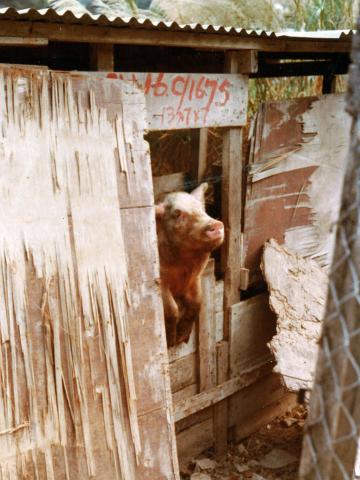
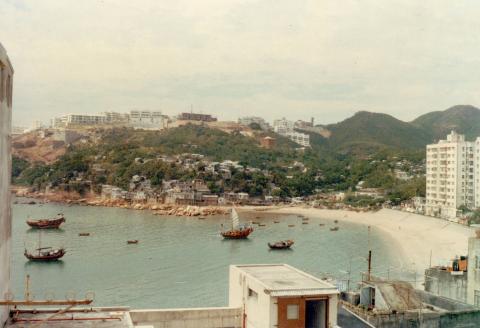
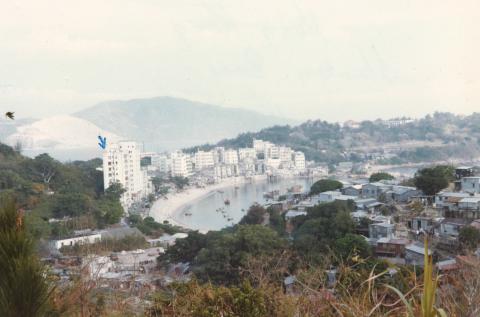
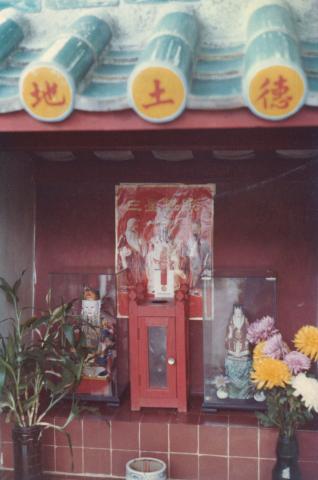
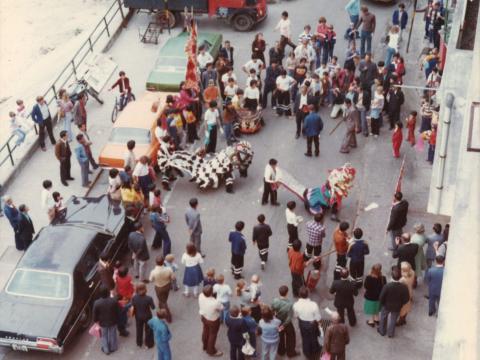
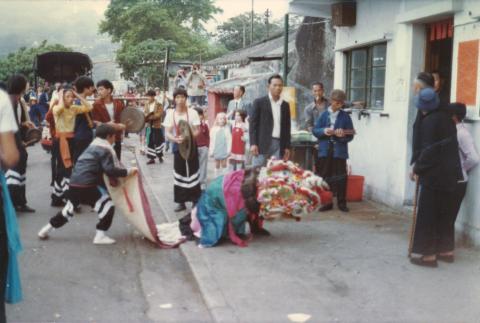
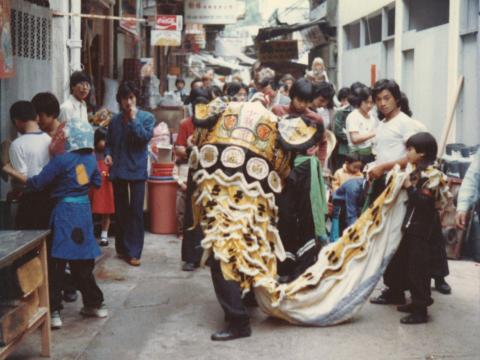
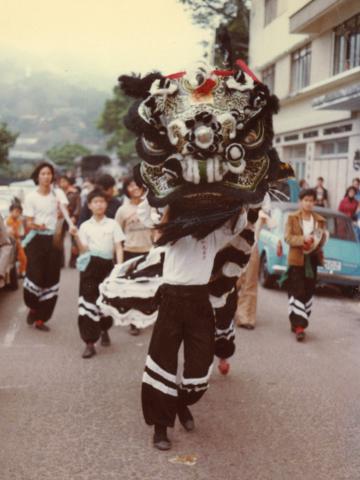
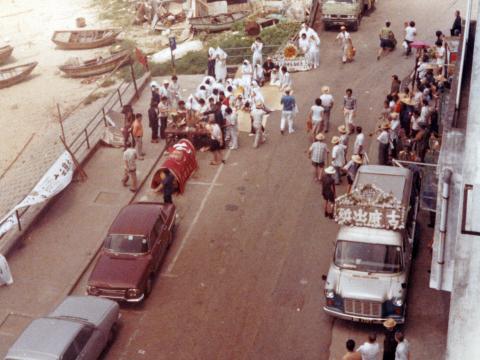

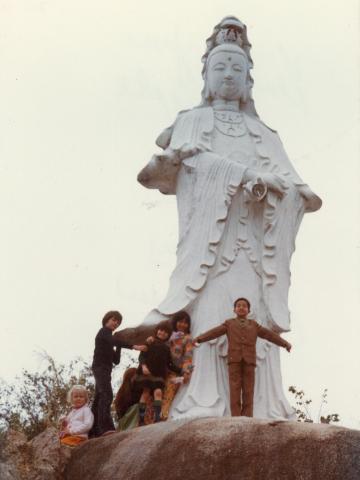


Comments
stanley memories
thanks kirstin for sharing these memories. i was brought up in kowloon but my family relocated to stanley in 1979 and they too had a flat in sea and sky court, first floor ! i enjoyed reading your article as it brought so much back. i lived there rent free 80/81 as i had left cash strapped portugal to make a few dollars, sounds like a similar re-run 30 years on... the shop on the ground floor was jane store, lovely family but at the slightest hint of a cold with one of the kids she was off to the doctor. i remember her husband darting into the bank next door to withdraw protection money for the waiting triads outside- at least that's what i think it was for.
mr szeto lived on the 6 floor of the same building and owned the wine factory
barclay fruit stall in the market, where the guy could peel a pineapple to perferction in 60 seconds, was one of those stalls still open at 9pm when i came back from work in kowloon- he did very well for himself in the stanley clean up as he owned some properties and sold them on. he is now owner of a massive farm in new zealand - good for him and family!
i moved into the amah's quarters because the bedroom i had was on the seafront and some days the stench of pig swill running down from the ma hang pig farmers village on the hill was unbearable, depended on the direction of the wind - now it is all impeccable and part of the stanley boardwalk. the smuggler's inn is amazingly still in business as it was just really a squaddie hangout in those days. my dad had a major disagreement over guess what - a hk thorn in the side - ludicrous rent hike, so moved to stanley village road by which time i was back in the old continent. great market too and wonderful roller coaster bus ride to get to stanley. again thanks for the walk down memory lane
Dear Kirstin Enjoyed your
Dear Kirstin
Enjoyed your article. I wonder if you knew my uncle who used to live in Apt.5B at the Sky&Sea Court. I used to stay with them at weekends & my cousin & I used to swim at the little bay.
Unusual animals around Stanley in the 1970s
I wonder if you ever saw or heard any stories of unusual animals near or in Stanley, such as tigers,leopards,large snakes,crocodiles,etc? This is for a book I am writing.I lived in Hong Kong between 1966-1985. I am familiar with the 1942 Stanley tiger.
Do you still have that newspaper cutting of the statue that supposedly moved?I would be very grateful if you could provide me with a photocopy and I will try and re-imburse costs.
Richard
Living in Stanley
I think I recall the man living upstairs from us, but vaguely. I do recall all the other things you mention and glad you liked Sea and Sky Court as much as I did. My daughter, Rachel, returned a few years ago for a visit and says the building is still there. Kirstin
animals in Stanley
I recall no wild animals in Stanley except for the packs of wild dogs that roamed the beach and village. Many adventures with them and our cats at the time. My children adopted many stray dogs which were then placed in the boxes for the Royal Society for Prevention of Cruelty to Animals for pick up.
There was the skin of the mountain lion in the Tin Hau Temple and I think that is the one you refer to.
I would have to search for the article on when Kwan Yin moved which appeared in The Standard. I saw it recently in a drawer or box but will have to search. If you want to email me at kmoritz@verizon.net with your email address, I can contact you if I find it. Best, Kirstin
wonderful
thanks for sharing these, kirstin. the pics and stories are truly wonderful. what an amazing time it must have been!
animals - south side
there were bands of large apes reported in the tai tam area in a book from the 1940s. a friend's campsite was approached by one in the 60s and they fled pretty quickly. not the same species as the monkeys out near shing mun but larger and darker
monkeys
The post about monkeys reminded me that in fact there were monkeys on the cliff behind Sea and Sky Court. So Richard, a memory of some wild animals. My children used to play up there and see them as I did. The building was supposed to have good feng shui because the sea was in front and the mountain behind it. It was a cliff with trees at the stop about half the height of the building with many good secret playing places and gardens in the woods behind. Lots of great birds could be seen in the area also. No memory of what they were except that the sounds were very exotic. Kirstin
Flat opposite
Hello Kirstin
Thank you for the memories - I think that I'm in the photo of us climbing on Kwan Yin - such an unfussy presence of Gods in their daily lives, no problems with small kids climbing on them. I remember our first day in Hong Kong. We'd flown in that night and arrived in the dark. I must have woken very early and looked out across the bay from the front windows. The view was so alien to me, 9 year old from Northern England. The junks and those ancient granite boulders, the hillsides covered in cement to stop landslides, and the secondary jungle spilling over the hills along with the shanty town. I tried to draw a pen and ink picture of it some years later but got the perspective all wrong so it looked like the rocks were floating above the sea - but somehow it captured the feeling of the place.
love
Dom
Stanley
Large Apes
Dear Vanessa
Thank you for this information,please can you tell me more about this, I am very interested in the name of the book if you can remember and if your friend is still alive please can you ask her or him more about the appearance of the ape which approached the campsite?
Thank you.
Richard
thank you
Dear Dom,
Thank you for your lovely comments. They do remind me of something your dear mother might write. She was so observant of things and I love the phrase, "unfussy presence of the gods" as that was a great photo of all of you and friends with Kwan Yin. Kara and Rachel loved the photo also. Best wishes to you and your family, Love, Kirstin
Stanley - Memories Recalled
I have been looking periodically for online resources depicting the 'old Hong Kong'. Finally, this site seems to fit the occasion.
As a child, I have lived with my parent in Stanley for 5 years, from 77 to 82. I was around six years old when we moved to Stanley from Bangkok (being from Germany originally). I attended the GSIS (German Swiss Intl School) loacted near the top of the Peak (Guildford Rd). In Stanley we lived on the third top floor of the center of the Gordon Terrace apartment. Revisited the site recently thanks to the new Google Street View availability. I have been back in person numerous times and ponder the chanes as time passes.
So much to say about my early years there. So many memories. Not a day goes by I don't think about the place. Things have changed. Many will say for the better, some may not, don't know wither. All I know that the 'stuff' the old days were made of is evaporating continously. It is increasingly difficult now to imagine the old days as many of the structures, squatter areas, streets etc were changed, upgraded, replaced, torn down...
What a time is was, and what unique memories were made. - I will attempt to post more.
Sea & Sky Court
I really enjoyed reading your reminiscences of Stanley Village and the various other comments. They brought back some wonderful memories.
I lived in 8A Sea & Sky between 1966-1969. We were some of the first to move in and for most of our time the ground floor shops were unoccupied and the owners of the building, the Yuens, lived in very basic conditions on the first floor.
Mr Yuen would entertain all of the residents on the roof every Chinese New Year.
I would say the only problem I ever had was that I could never get used to the smells from the food market and the rice wine fermentation in the village.
Some names I remember are the Sandersons (6th floor) and theWightmans (8b) but I suspect they will have left by the early 70s.
Thanks for your memories.
Very best regards,
Carl
Memories of Stanley
Some very interesting reminiscences of Stanley here. I was the policeman in charge of Stanley Sub-Division in the mid-1980's, for 2 years, and I also have fond memories of the place. I remember well Mr. Szeto Tong who owned the Chinese wine distillery - or should I say, what used to be the wine distillery. I think by the mid-80's Mr. Szeto, who had bought out his siblings to take possession of the property from his late father, had converted it to a large emporium.
But let us not mince words here. Ma Hang squatter area was a blight on the landscape. The Government adopted a "hands off" approach to the pig-breeding, an illegal activity which was an environmental disaster. As certain people who are still around (so I won't name names) will tell you, on those days when the wind blew from the direction of Ma Hang the stench from the "pig farms" in Ma Hang made sitting out in parts of Stanley an absolute nightmare.
Allow me to clarify a couple of errors above. The animal skin which hangs in the Tin Hau Temple is of a tiger, not a mountain lion. Nobody, and I repeat nobody, knows with 100% certainty how the tiger appeared in Stanley. Some say it had escaped from a circus visiting HK when the Japanese invaded in 1941 - I say unlikely. Probably from southern China, in my view. We know it was shot by an Indian police Constable under Japanese direction in 1942.
George Wright-Nooth covers the subject in quite a bit of detail in "Prisoner of the Turnipheads."
The British military moved to Stanley in the early 1840's - not long after they took the island of HK - as they felt it was a more healthy and salubrious location. Men were dropping like flies from malaria in places like Happy Valley. By the 1920's the garrison (on the site of St. Stephen's College) was too small, and the Army wanted to move to the Stanley headland. It just so happened that the trustees of St. Stephen's College wanted to move the school campus, as the site they had been occupying since 1903 in Western was becoming too small.
In the late 1920's a game of musical chairs developed. The Army garrison moved to the site of what is now Stanley Fort, in so doing displacing some villagers who were moved in turn to Pak Gaan (8 houses) which were built for them. This allowed St. Stephen's College to move to the site vacated by the military. Every one a winner.
All for now. Another time I will recall the fun and games I had with commercial filming in Stanley - including the time a film company tried to take over the whole village to film "Noble House." They soon moved when I pointed out that Pierce Brosnan probably wouldn't like to see a police cell close up.
Much discussion here on the
Much discussion here on the 1942 tiger. I have never seen a definitive answer as to where it came from